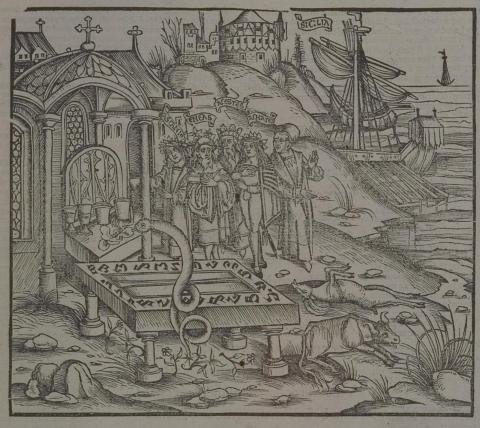Annotations
Aeneas and his followers have landed at Dardanus in Sicily, the burial place of Anchises. Aeneas, Ascanius, Acestes and Achates, wearing garlands of myrtle (72-4), stand by the shrine of Anchises. A priest stands next to them. A very mature Ascanius pours a liquid offering onto the altar. There are five goblets shown, though Vergil describes six: two hold unmixed wine, two hold fresh milk, and two hold the blood of the two oxen that lie dead to the right of the tomb (Hīc duo rīte merō lībāns carchēsia Bacchō fundit humī, duo lacte novō, duo sanguine sacrō, purpureōsque iacit flōrēs ac tālia fātur 77-8). Flowers have been scattered around the edges of the tomb (79). A large serpent rises up in front of the tomb, and, stretching across it, sticks its tongue out to taste the liquid offerings (84-9). (Katy Purington)
Woodcut illustration from the “Strasbourg Vergil,” edited by Sebastian Brant: Publii Virgilii Maronis Opera cum quinque vulgatis commentariis expolitissimisque figuris atque imaginibus nuper per Sebastianum Brant superadditis (Strasbourg: Johannis Grieninger, 1502), fol. 232r, executed by an anonymous engraver under the direction of Brant.


Sebastian Brant (1458-1521) was a humanist scholar of many competencies. Trained in classics and law at the University of Basel, Brant later lectured in jurisprudence there and practiced law in his native city of Strasbourg. While his satirical poem Das Narrenschiff won him considerable standing as a writer, his role in the transmission of Virgil to the Renaissance was at least as important. In 1502 he and Strasbourg printer Johannes Grüninger produced a major edition of Virgil’s works, along with Donatus’ Life and the commentaries of Servius, Landino, and Calderini, with more than two hundred woodcut illustrations. (Annabel Patterson)